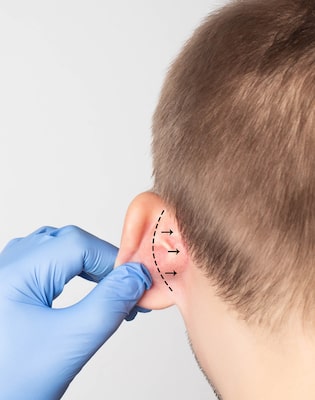
The ears are one of the most visible parts of the body which can be good news or bad news for a person. The reason it can be good or bad news is because some people do not mind the appearance of their ears while others are not happy with the size or shape of their ears. Otoplasty is a surgical procedure that is performed to reshape the outer ear (which is also known as the pinna). The surgery can be performed to simply alter and enhance the aesthetic look of the ears or to correct an irregularity that might be visible on the ears.
In general, the ears are normally around two centimeters from the side of the head. Ears that are more prominent than this can have a look that is oversized in appearance. There are also some people who have sustained some sort of damage to the ears due to an accident or they were born with a congenital anomaly to the ears that makes them want to undergo reconstructive surgery in order to repair the ears.
A surgical procedure that is performed to improve the look of the ears is known as otoplasty. Besides making a change in the look of the ears, otoplasty can also promote greater self-esteem and make a person happier with their appearance. While otoplasty is not generally considered to be a “necessary” surgery, it can help a person in a manner beyond the changes to the look of the ears.
 When it comes to children and otoplasty, an ideal time to have the surgery is when the child is five or six years of age because the ears have reached about 90% of their growth by this point. Plus, a person can have otoplasty at any age after the age range of five or six years.
When it comes to children and otoplasty, an ideal time to have the surgery is when the child is five or six years of age because the ears have reached about 90% of their growth by this point. Plus, a person can have otoplasty at any age after the age range of five or six years.
For babies, a nonsurgical technique that is known as splinting or ear molding can be performed during the first two or three weeks after the birth of the child. If ear molding is not performed at this time, the child will need to wait until ages five or six to have surgery.
The need to alter the look of the ears can occur if the outer ear is at an angle of more than 30 degrees from the side of the head (to the point where it “sticks out”). In addition, there are health conditions or genetics that can impact the growth of ear cartilage as well as trauma or an injury to the ears that can alter their appearance. Thankfully, the appearance of prominent ears should not have a negative impact on the ability of a person to hear properly.
During otoplasty, the surgeon will give the patient an anesthetic in order to help maintain any pain and make the person more comfortable. An incision is then created behind the ear in order to cut out the necessary amount of cartilage or skin to make the desired changes. The incision is then closed with stitches. If both ears are treated during the procedure, this is known as bilateral otoplasty.
In an ear molding procedure, the surgeon uses a splint to reshape the soft cartilage that is present during the first few weeks of life of the infant. The splint is used to support the ear and keep it in place in its new position. The splint is held in place with surgical tape, and it should be worn 24/7 for a period of a few weeks to a few months. Ear molding needs to be performed before the age of six or seven weeks because the cartilage will start to stiffen at that point in time.
The extent of the recovery process depends on the type of surgery performed by the doctor. After the procedure, the doctor will place a dressing over the ears, and it will need to stay in place for several days.
Once the dressing is removed, the patient will likely need to wear a protective headband over the ears. This is especially true at night as the ears need to be protected and prevented from being pulled forward as a person sleeps.
There will be some soreness for a few days after the procedure along with some amount of bruising, numbness and tingling for several weeks. There is also the chance of an infection occurring after the treatment and even a need for a revision surgery if the ears start to stick out again (which does not happen often), the ears are asymmetrical in appearance, or the ears are still too far from the head.
Patients need to have realistic expectations about the type of results they can expect to achieve. The doctor can give the patient an idea about the type of results they will see and also share the pros and cons of otoplasty so the person can make an educated decision about having the treatment.
- MA